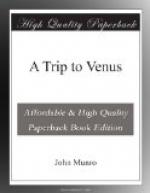“Not without its jars, I’m afraid.”
“The sun is chief of the clan,” continued Gazen, “and keeps it together by the mysterious tie of gravitation. While flying through space, he turns round his own axis like a rifle bullet in 25 or 26 days. His diameter is 860,000 miles, and although he is not much denser than sea-water, his mass is over 700 times greater than the combined mass of all his retinue. Gravity on his surface being 28 times stronger than on the earth, a piece of timber would be as heavy as gold there, and a stone let fall would drop 460 feet the first second instead of 16 feet as here. He is built of the same kind of matter as the earth and other planets, but is hotter than the hottest electric arc or reverberatory furnace. Apparently his glowing bulk is made up of several concentric shells like an onion. First there is a kernel or liquid nucleus, probably as dense as pitch. Above it is the photosphere, the part we usually see, a jacket of incandescent clouds, or vapours, which in the telescope is seen to resemble ‘willow leaves,’ or ’rice grains in a plate of soup,’ and in the spectroscope to reveal the rays of iron, manganese, or other heavy elements. What we call ‘faculae’ (or little torches), are brighter streaks, not unlike some kinds of coral. The ‘Sunspots’ are immense gaps or holes in the photosphere, some of them 150,000 miles in diameter, which afford us a peep at the glowing interior. There are different theories as to their nature, hence they provide rival astronomers with an excellent opportunity of spotting each other’s reputations. For instance, I look upon them as eruptions, and Professor Sylvanus Pettifer Possil (my pet aversion) regards them as cyclonic storms; consequently we never lose an opportunity of erupting and storming at each other.




